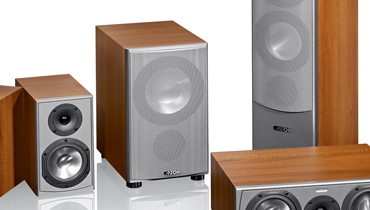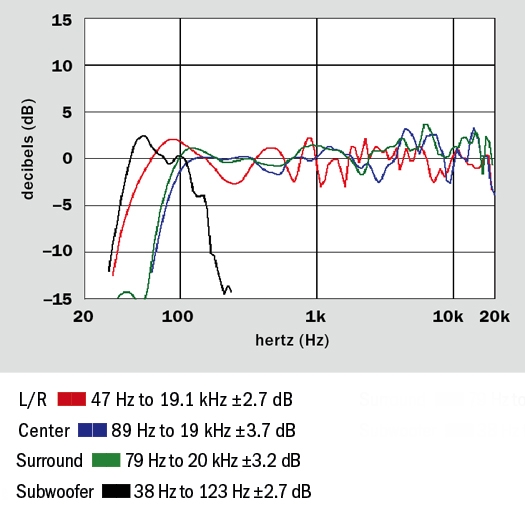Canton GLE Series home theater speaker system Page 3

TEST BENCH

Sensitivity (SPL at 1 meter with 2.8 volts of pink-noise input) Fromt Left/Right: 91 dB Center: 90 dB Surround: 88 dB
Impedance (minimum/nominal) Front Left/Right: 3.2/6 ohms Center: 4.2/6 ohms Surround: 3.6/6 ohms
Bass limits (lowest frequency and maximum SPL with limit of 10% distortion at 2 meters in a large room) Left/Right: 32 Hz at 70 dB Center: 80 Hz at 84 dB Surround: 62 Hz at 70 dB Subwoofer: 25 Hz at 76 dB SPL 93 dB average SPL from 25 to 62 Hz 104 dB maximum SPL at 62 Hz Bandwidth uniformity 89%
All of the curves in the frequency-response graph are weighted to reflect how sound arrives at a listener's ears with normal speaker placement. The curve for the left/right front channels reflects response of the GLE 490 with the speaker standing on the floor averaged over a ±30° window. The center-channel curve reflects response of the GLE 455 averaged over ±45°, with double weight directly on-axis of the primary listener. The surround-channel curve shows the response of the GLE 420 averaged over ±60°.
Because the GLE 490 will always be used on a floor, measurements were taken with the speaker positioned thusly. Both the center and surround channel speakers were measured on a 6-foot stand, which gives anechoic results to approximately 200 Hz. All speaker measurements, subwoofer excepted, are taken at a full 2 meters, which emulates a typical listening distance, allows larger speakers to fully integrate acoustically, and, unlike near-field measurements, fully includes front-panel reflections and cabinet diffraction.
The GLE 490 has a basically flat bass-to-treble balance, with narrowband irregularities, including a 2.7-dB floor bounce, centered at 247 Hz, and +/- 2.5-dB peak/dips between 650 to 850 Hz. The GLE 455 has a small 2.5-kHz dip that deepens as the microphone is moved past ±22° off-axis. Otherwise, the speaker's response is characterized by narrow peaking at 4.4 kHz, 6 kHz, and 14 kHz. The GLE 420 surround channel also displays several narrow peaks at 5.5 kHz, 8.9 kHz, 14.2 kHz, and 17.4 kHz, along with a mild 2.5-dB elevation between 600 Hz and 2 kHz.
The AS 85 SC Subwoofer's bass limits were measured with it set to maximum bandwidth and placed in the optimal corner of a 7,500-cubic-foot room. In a smaller room users can expect 2 to 3 Hz deeper extension and up to 3 dB higher sound-pressure level (SPL). The subwoofer has limited dynamic capability, with SPL falling off at 17 dB per octave below 62 Hz. And its maximal clean SPL capability is limited by port "grunting" triggered at lower frequencies.
Although the sub does not have a specified upper bandwidth (the output is -3 dB at 123 Hz when the crossover dial is set to 150 and 200 Hz), the actual turnover frequencies tend to match the dial markings over the rest of the range, and there is no level interaction except at the very lowest crossover settings. Along with the general absence of level/crossover interaction, a click-stop crossover dial makes establishing and resetting crossover settings more convenient. The sub's "Narrow" Room Compensation setting cuts output by roughly 5 dB below 55 Hz and simultaneously increases output by just under 2 dB above 55 Hz.













































